#book ad in the hindu
Explore tagged Tumblr posts
Text
The Hindu Classifieds: A Pillar of Excellence in Indian Advertising

#ad in hindu#ads on hindu#classified ads in hindu newspaper#hindu ad#hindu advt#hindu classified#hindu classified ads#hindu classified advertisement booking#hindu classified booking#hindu classifieds#hindu newspaper ads#hindu newspaper advertisement#hindu newspaper ad booking#book ad in the hindu#the hindu advertisement#the hindu advertising
0 notes
Text
Navigate the World of Possibilities with The Hindu Classifieds!

#the hindu classified ads#classified ads in hindu newspaper#hindu classified#hindu classified ads#hindu classified advertisement booking#hindu classified booking#hindu classifieds#hindu newspaper classified#hindu newspaper classifieds#the hindu classifieds
0 notes
Text
The Hindu Classifieds: Unlock the Door to Your Dreams!

#the hindu classifieds#classified ads in the hindu newspaper#hindu classified ad booking#the hindu classified advertisement#the hindu classified advertising#hindu classified advertisement#book hindu classified ad online#hindu classified ads#the hindu classified ads booking
0 notes
Text
PSA: Mana doesn't exist in Dungeon Meshi
Some translations of Dungeon Meshi (specifically the English anime and Yen Press manga) have used the word mana to describe magic, when the original Japanese simply said magic (mahou, 魔法) or magical power (maryoku, 魔力).
Ryoko Kui does not appear to use the word mana (マナ) at any point in the manga, the published extra materials, or her blog, so calling magic “mana” is an addition made only in some translations.
For example, the French translation does not use "mana." If you know of other translations that do or don't use mana, let me know!
The use of the word mana in English comes from Maori and its earlier Proto-Oceanic ancestor language.
It describes a form of supernatural power tied to social status, respect and strength. Mana is a religious concept for many Austronesian cultures, and is not really "magic" in the way pop culture has defined it.
As best as I can understand it from an outsider's perspective, mana is more like attributing a supernatural quality to a person's charisma, or the awe one feels when faced with a natural wonder like a mountain or the ocean, or the intimidation one feels when facing a powerful group.
The use of the word mana as a generic term to refer to magical power has been criticized as being cultural appropriation of a real religious term, still used by living people, to describe fictional magic.
In addition to this, using an Austronesian word at random in Dungeon Meshi for one of the most important and fundamental forces of the universe (magic) is inorganic to the world that Kui has constructed, which is rooted primarily in Greco-Roman, Hindu/Buddhist Indian, Middle Eastern, and Germanic cultures.
Using mana to refer to magic would suggest that the Ancient culture from before the cataclysm was Austronesian, but the rest of the manga does not support such an idea at all.
There are references to Austronesian and Oceanic cultures in Dungeon Meshi, but they are mostly tied to the orcs, who don't appear to use magic, and whose culture clearly doesn't, and has never had, the social power to define what word the rest of the world uses to refer to "magical power."
How did a Maori word get so popular in English?
The concept of mana was introduced in Europe by missionary Robert Henry Codrington in 1891 after he wrote a book about his time in Polynesia. The concept was then popularized further in America in the 1950s by Mircea Eliade, an extremely influential religious history scholar at the University of Chicago.
Mana was first introduced as a magical fuel used to cast spells in the 1969 short story, "Not Long Before the End", by Larry Niven. Around this time it also became popular with new-age religious groups.
It has since become a common staple in fantasy fiction and games.
So why translate it as mana?
The choice to translate "magic" and "magical power" as mana was probably made to try and make Dungeon Meshi sound more like a video game/RPG, since so many Japanese fantasy manga feature video game or RPG mechanics, and translators working on Dungeon Meshi would have no reason to assume it would be any different, especially at the very start of the manga.
However, Dungeon Meshi is much closer to High/Epic Fantasy, like Lord of the Rings, and throwing random gaming terminology into the translation when it wasn't in the original text ("mana", "newbs" and "inventory" instead of "magical power", "newcomers" and "supplies") feels out of place.
I think adding the term mana is a disservice to the hard work that Kui has done with her careful attention to linguistic detail and culture.
In the process of working on my Dungeon Meshi research paper on real world cultural references, I have studied over 100 names and words used by Kui, and I have found that she is remarkably thoughtful and consistent in what real world cultures and languages she pulls from, and what fictional cultures she pairs them with.
Obviously I don't blame the translators for not knowing this, they had to make translation decisions before the entire manga was complete, and most likely they were doing work for hire, with no idea what Dungeon Meshi was about.
They had no way of knowing Dungeon Meshi wasn't a video game fantasy comic, and were just trying to rush through their work as fast as possible in order to get paid, and move onto their next project.
Once it became apparent that Dungeon Meshi was High Fantasy and not a world that functions like a video game, they'd already used the word mana, so there was no going back.
In an ideal world, if the translators had known the type of story Dungeon Meshi would become from the beginning, if they really wanted a single word to translate "magical energy" into, they could have picked a word that belongs to one of the language families I mentioned before, rather than using mana just because "everybody uses mana, so readers will know what it means."
What should I call magic power then?
If reading all of this has made you want to stop calling it mana, hooray! Thanks for listening to me rant. You could just call it magical power, if you wanted. Nothing wrong with that!
But if you want something a little less clunky, here's an incomplete list of possibilities in some of the languages most commonly referenced in Dungeon Meshi. Please note I have not done due diligence on every one of these, I believe none of them are exclusively religious terms still in use, but just words that could mean magic (both fictional and real) in various languages. If I'm wrong about any of them, let me know.
INDIAN: Maya, prana. MIDDLE EASTERN: Sihr, kiisum/kesem. GRECO-ROMAN: Ergon (as a euphemism), goteia, physis, numen/numina, mageia. GERMANIC: Seidr, galdr.
(This post is an excerpt from my Dungeon Meshi essay with additional elaborations.)
291 notes
·
View notes
Text
Staff Pick of the Week
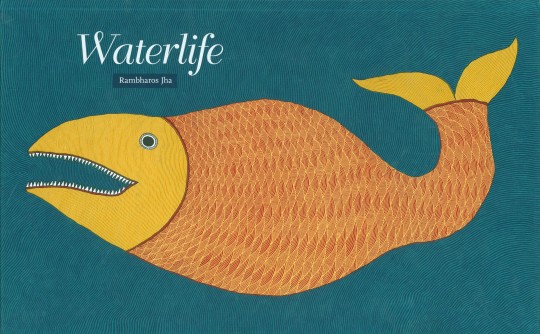






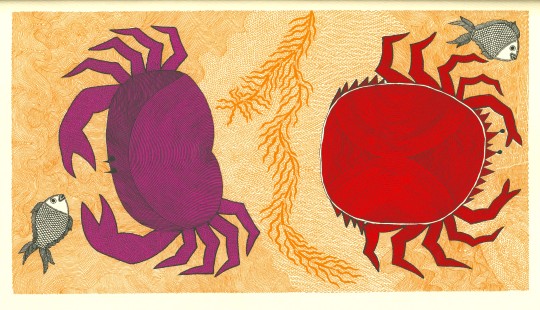
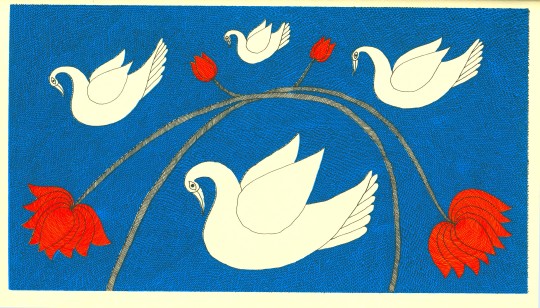
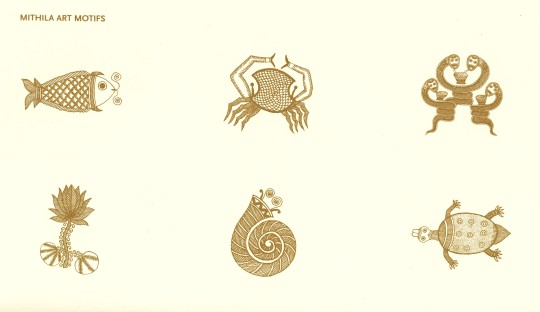
Growing up near the Ganga River in the cultural wellspring of Mithilia, Rambharos Jha spent much of his childhood observing the natural world and traditional arts of the region. When his father began working with a government project to breathe life into local art traditions, Rambharos had the opportunity to study Madhubani women painting walls and courtyards in their renowned Mithilia style utilizing natural dyes and pigments to depict people engaging with nature and deities.
Inspired by these encounters, Rambharos began his artistic painting career in line with the traditional motifs of Hindu mythology but has since evolved his practice to better represent his personal experiences and experimental mediums. Waterlife, published in 2012 by Tara Books, is a culmination of Rambharos���s efforts to balance the delicate traditions of Mithilia art with his contemporary ideas. Waterlife is silkscreen-printed by hand on handmade cotton paper and masterfully plays with adding movement and new subjects and environments to the classic Mithilia medium marrying Rambharos’s childhood memories and folk legends.
View more Staff Picks here.
-Jenna, Special Collections Graduate Intern
#Staff Pick of the Week#rambharos jha#waterlife#tara books#mithilia art#screenprinting#handmade paper#staff pick#silkscreen#Indian art#Madhubani India#Jenna#artists books
151 notes
·
View notes
Text
interview with priya das from bihar, who came under fire for burning the hindu scripture "manusmriti" and using it to both cook chicken and light her cigarette.
adding this because it seems necessary for some reason and in anticipation of this post potentially breaking containment; due to the debate happening in the US regarding the banning of books from school libraries, I'd request all of you to please consider that this book is foundational to the prevalence of practices such as caste-based bigotry and endogamy, and that burning it as a political stance has been in practice since the 1940s. do not argue about freedom of speech in the notes.
459 notes
·
View notes
Text
People have tried so hard to pretend that Nietzsches anti-Semitism is caused by his 'lying, conniving sister' when all of her edits were to make it appear like she had a closer relationship with him for longer than she actually did in order to justify her own position and liveliehood as his literary executor after her own husband died. If she ever edited his anti-Semitism it was to make it less bad than it actually was, and she did condemn, both publiclly and in private,Nazi anti-Semitism (while still on the whole being pro-hitler - not particularly bright, but nonetheless her condemnation of antisemitism was serious). It was Nietzsche who introduced her to anti-Semitism as an intellectual project, through the writings of Wagner as well as his own correspondence with her being full of casual anti-semitism.
Extreme anti-Judaism is the root of his intellectual project, even after his break with Wagner, and his extremely positive writings on an antisemitic fabrication towards the end of his life - the supposed translation of the Hindu text The Law-Book of Manus with a bunch of added texts implying that the Untouchables are Jews - show that this was a constant throughout his most developed work. Even his supposedly pro-jewish writings are often painted with this inversion of anti-Semitic tropes - the Jews, in their national loyalty and their successful domination of Europe through financial institutions, are a positive example of the Will to Power who's financial abilities should be bred into the new European aristocracy that he wanted.
Nietzsche was an anti-Semite, he was a reactionary pro-aristocrat, and a precursor to the German Conservative Revolutionary current. His objection to German organised anti-Semitism was that it was plebeian, not that it was anti-Semitic.
53 notes
·
View notes
Text
Gerudo Language 3.5 - Verbs
Here is the Gerudo alphabet:

And this is what I think the Gerudo's numerical system would look like based on the above alphabet & my personal headcanons.
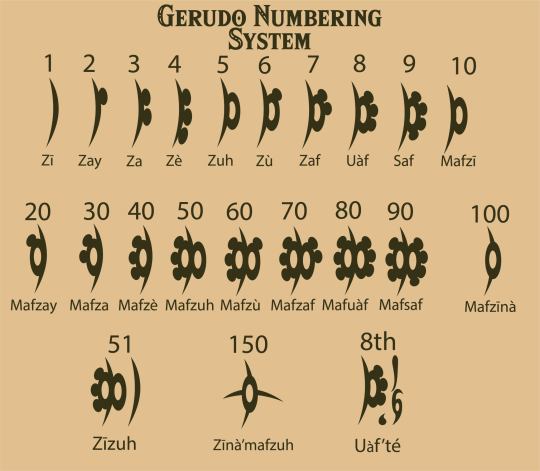
—
I am basing this all off of both official Nintendo approved words, a bunch of other people's ideas, as well as a mix of Egyptian, Middle Eastern, Sanskrit, & Hindu words & random shit that I pull from betwinxt my booty-cheeks. So, be warned.
For the rest of my Gerudo Language Series, go here: Part 1, Part 2, Part 3, Part 3.5, Part 4, Part 5, Part 6, & Part 7.
Words with a * at the front indicate that I'm not the one who thought it up. Basically, a disclaimer.
A lot of them are likely from Va Ehenihv's site, so if anyone from there comes across this & wishes for me to remove some things from here, I am more than willing to discuss.
—
Pronunciation & Diacritics:
When ' (called a 'Khàmza) is both proceeded & followed by a consonant, the 'uh' sound is added in between when spoken, but when it's proceeded or followed by at least 1 vowel, it isn't. Unless, it's proceeded by an 'H' that, itself, is proceeded by a vowel. Then, the 'H' is also treated as a vowel. Or when the consonants on both sides are the same. In which case, the 'uh' is not pronounced. Eg. Sol'let is pronounced like 'solet.'
'J' either sounds like 'y' or like 'zh'/'jh' depending on the letter before it. 'Zh' or 'jh' as in 'zhuzh it up' or 'give it some jhoojh,' so sort of a buzzing or engine-revving sound. If the proceeding letter is a vowel or a vowel & an 'h,' it sounds like an 'h,' but if it is a consonant or the start of a word, it sounds like 'zh'/'jh.' In the case of being proceeded by a 'd,' the 'd' is silent, but the 'j' still behaves as if proceeded by a consonant. However, if the 'j' is proceeded by ', then it automatically makes the 'jh' sound.
Rr is pronounced like the rolling Spanish "rr."
X is pronounced either like "sh" or "zh" depending on the situation. Except for when it's proceeded by an "h" or ', at which point, it comes out sounding like "sk" or "shk."
A is pronounced like "uh."
Á is pronounced like "a," as in "bat." (When spelled in English phonetically, it's written "bæt" with a hard "a.")
À is pronounced like the "a" in "are."
Ā is pronounced like "ay," as in "day."
E is pronounced with the short "e" sound.
È makes the "eh" sound.
É makes the "ey" sound.
Ē makes the long "e" sound.
I makes the short "i" sound, like the "ick" in "sick."
Ï makes the long "e" sound, same as "ē."
Ī makes the "eye" sound.
O sounds like the short "o" sound, as in "on," "off," or "long."
Ó sounds like "oo," but shorter.
Ō sounds like the "o" in "home."
Ô sounds like "aw" or "ow."
U sounds like "uh," same as "a." Also sounds like the "i" in "third" or the "ea" in "earn" depending on how it's used.
Û sounds like "oo," but longer.
Ù sounds like the "oo" in "pool."
Ú sounds like the "oo" in "book."
Ae sounds like "hah" with a lot of breath in the "h"s.
And this is how I think the diacritics would be spelled.

Ā, É, & Ī all have 2 ways to write them, the 1st of each listed being considered formal & proper, while the 2nd listed are consider informal & casual.
I've also made a few digraphic characters.
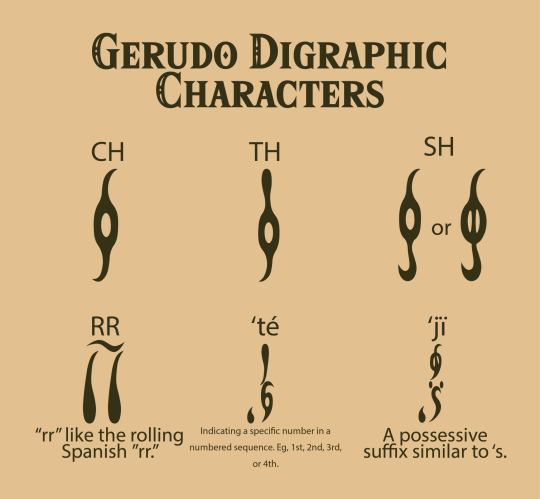
---
Also, if you happen to see repeat words, like same Gerudo word used multiple times for vastly different things, I'd very much appreciate a heads up.
Grammar:
Names do not have ' in them as a rule.
-'ōt (Pronounced: -oht) = Very or so. Eg. Sàv'ōt means "very good" or "so good." Sàv'ōt being used as praise or to complement cooking or in other, more intimate situations.
-'té (Pronounced: -tey) = -th, -rd, -nd; a specified number in a numbered sequence. Eg. Uàf'té (Pronounced: oo-ahf-uh-tey) means 8th. The letters are regularly smaller than the number & are arranged one on top of the other in a column.
-'è = Suffix indicating "of." To be placed at the end of what is possessing. Eg. Goddess of the Sand would be Geru'è Vallah.
-'jï (Pronounced: -jhee or -zhee)= Possessive suffix. So, if something belongs to Aaqlet, then it's Aaqlet'jï. Much like with -'té, the 'j' & 'ï' are also smaller than the rest & stacked on top of each other in a column.
-éda = -ing. Suffix indicating that something is happening right now.
-'úl or úl (Pronounced: ool) = Indicating that something happened in the past. Past tense.
-en or -n = An indication of a word being plural. Both are technically correct, but 'en' is considered proper grammar. Some words already end in '-n' & when it isn't proceeded by an 'e,' you can just tack '-en' to the end. Making '-n' into '-nen.'
- -ae = Another way to indicate plurality. This is typically done when the word ends in '-a.'
Ih'- = A or an. Used as a prefix to a word.
Adï'- = Adoptive or surrogate. Used as a prefix.
Dōr'- = -less. To be without something.
-īs = -ful. To be full of something.
Kōli'- = Every-. Used as a prefix indicating all of something.
Muhs'- = Not or un-.
-ubé = -tion.
*Dulï'- = Any-. Used as a prefix in words such as anywhere, anything, anyone, ect.
- *Dulï'vomoq = Anyhow.
- Dulï'zī = Anyone.
- Dulï'mihd = Anywhen.
- *Dulï'fihk = Anywhere.
- *Dulï'fàyo = Anymore.
- *Dulï'xakè = Anybody.
- *Dulï'rekàna = Anything.
- *Dulï'tïto = Anytime.
-xē = An indication of something being more. Such as deeper, bigger, greater.
Wahl'- = And. Used as a prefix for the last item in a list.
Al'- = The. Traditionally has the ', but in situations where other prefixes are applied, the 2 prefixes are merged.
-qiz = Suffix used to mean “-en.” Like, awaken.
-ūn or -ám = -en or -an, but as in, a state of being something.
Lï'- = To. Used as a prefix to indicate an action, but only when "to" is necessary. Eg. Lï'kaa is "to do."
Yà- or -yà = Little or small. Used as either a prefix or suffix to indicate a diminutive. Often used in terms of endearment.
- Yàrï- or -yàrï = Tiny or teeny, but specifically in reference to the object of the speaker's attentions' cuteness as a side-effect of said smallness. Like, an ultra diminutive. Often used in terms of endearment as a suffix & is basically baby talk. - Vai will also often sing "yàrïyàrïyàrï~" at babies or puppies or kittens as a way to say how sweet & cute they are, thus being the equivalent to "coochi-coochi-coo," but what they're actually saying is "tiny-tiny-tiny." - Conveys great affection, but is strictly for platonic or parental use. Not normally for romantic use. Also often used to indicate an infant form of something, but in a baby-ish way. Eg. Gàtïyàrï for kitten. But it's used in a way so as to say, "Look at this little baby cat! Isn't it precious?!" So, not used as an official or scientific term.
-zī = One. Can be used as a suffix in addressments.
Và'- or Và- = A prefix referring to a female. Was once used to shorten long feminine terms, but is now used regularly.
Vo'- or Vō- = A prefix referring to a male. Was once used to shorten long masculine terms, but is now used regularly.
Ran or Dā- = Great, big, or glorious.
Fé or Nae = In. Also used as a prefix.
- Févūju or *Naevūju = Inside.
- Fé'lï or Nae'lï = Into.
Ta'- or Ta = Out.
- Ta'letraq = Outshine.
Vataa = Or.
- Taa or -taa = Or. Shorthand. Also used as a suffix at the end of items in a list of options.
Indicitive Prefixes:
*Nï’- = I (verb).
*So’- = You (verb).
*Fu’- = He (verb).
*Va’- = She (verb).
*Ween’- or Wēn’- = (Inclusive) We (verb).
*Neen’- or Nēn’- = (Exclusive) We (verb).
*Soen’- = Ya'll (verb).
*Foon’- or Fùn’- = (Masculine) They (verb).
*Vaan’- = (Feminine) They (verb).
*Shūn’- = (Masculine & Feminine; specifically in the plural sense, not for singular use) They (verb).
In modern days, when an indicative is followed by a verb, it can be used as a prefix for that verb.
Possessive Suffixes:
-nï = My.
-so = Your.
-fu = His.
-va = Her.
-ween = Our & your.
-neen = Our, not your.
-soen = Ya'll's.
-foon = Masculine their. This term has been nearly lost.
-vaan = Feminine their.
-shūn = Masculine & feminine their. Used to indicate that there are either both men & women or that the speaker isn't sure. For plural use only.
When not used to indicate possession, should be accompanied by a ‘. For instance, "bury me" would be Biru'nï. Otherwise, the word comes out more like "my bury," which makes very little sense.
Verbs:
When unaccompanied, verbs end with a "ù." The "to" at the beginning is generally just implied, but when the "to" is used in an actual sentence, the word starts with "Lï'-."
When "to be" words are actively used & require the "be," they start with the prefix "Zeq'-" or "Zo'-."
When both are required in the sentence, use "Lïzo'-."
When a verb requires “get,” it starts with the prefix “Tah’-.”
Zeqù = To be.
- Zù = To be. Shorthand.
- Zo = Be.
*Uayù = To have or own.
*Kaalù = To do.
Dù = To go.
*Yàkù = To carry.
Balù = To bring.
- al'Ântri’è Balïj = The Bringer of Demise.
Lhàrmsikù or Lhàrmkù = To hold.
- Lhàrmkah = Holder.
Sanhītù = To bear.
- Sanhītumù = To endure.
Litufūpàrù = To loom overhead.
Dôrù = To turn.
- Dôrnae'lù = To turn into.
- Dôrnae'lï = Turn into.
Zo'kodīqù = To be tight.
- Kodīqiz = Tighten.
Yajàbù = To wonder.
Tokhù = To open.
Haeduthù = To happen.
Jōshtànù = To sing.
- Jōshtàno = Sing.
- Jōshtia = Song.
Pàrasnù = To make.
Zo'kitabù = To be satisfied, satiated, or sated.
- Kitabae = Satisfy, satiate, or sate.
Zo'xànù = To be certain or sure.
*Qasù = To become.
Àmlōtù = To accept, agree with/to, or have a positive opinion.
- Àmlōta = Accept.
Īnshù = To will.
Yasheù = To feel.
*Xïhnù = To taste.
Hàvmaeù = To hear.
Pachūnù = To touch.
*Vur'nù = To see.
- Vur'hyaanù = To watch.
Nolù = To offer.
- Noli = Offer.
*Kàlù = To take.
Aktù = To give.
*Sāqsù = To live.
*Sorqù = To die.
Vashorqù = To destroy.
*Uàrù = To break.
- Uàrïr = Breaker.
*Situkolù = To dominate.
Gàtagù = To kill.
Uregàtù = To murder.
- Uregàta or Urego = Murder.
Gib'balù = To execute. Lit. “to bring death.”
Ghéshtànù = To conceive or create.
Nihayàntù = To end. To bring an ending. To close. To finish. To terminate. To bring terminatus.
Ântù = To end, conclude, finish, close, cease, doom, terminate, termitus, expire, expirate, evanish, surcease. Can be used to mean “to bring an end to something or someone in a dramatic fashion.”
Hālákù = To destroy, perdit, bane, end.
Vīlumaaptù or Vīluptqïràdù = To make extinct. Indicates something of a finality. To smother or snuff out.
- Vīlumaapti = Extinct. Indicates something of a finality. Smother or snuff out.
*Kàlehbù = To finish or complete.
Upyàzù = To visit.
Syātù = To pick/pluck.
Tàrāmbàstù or Tàrāmekù = To string something together. Ex. A necklace or words.
- Tàrābàsta or Tàrāmeka = String together.
Bīvtekù = To enchain. Lit. “to chain together.” Refers to the act of enchaining, or state of being enchained. As in, to chain or link together.
- Bīvteka = Enchain.
Sitaklàtù = To drape.
Tàzkrutù = To decorate.
Vistaarù = To expand.
Vistaar'ūpù = To expand upon; to explain.
- Vistaar'ūpàr = Expand upon.
Làgatù = To seem.
Hibù = To like. As in having a positive opinion of something.
- Nahibù = To dislike.
*Sahqaz'nù = To wish.
Tumainù = To hope.
Saarqù = To prepare.
- Saarqubé = Preparation.
*Būjù = To steal.
- *Màgbūjù = To steal (food).
- *Vībūjù = To steal (jewelry).
- *Rūbūjù = To steal (rupees).
- Chibūjù = To steal (a heart).
-- Chibūjhōr & Chibūja = A thief who steals hearts. Used to refer to heartbreakers, casanovas, lotharios, femme fatales, homme falates, ect. Regardless, it's used to mean someone who is charming, suave, but also dangerous. Though, mostly for your heart.
*Vaaqontù = To say/tell.
- *Sabottù = To speak/talk.
*Vaq'ribù = To laugh.
Rakàdù = To cry/weep.
Bokàdù = To weep/sob.
Huzkàdù = To grieve.
Yōjaytù = To connect.
Ehnyiqù = To tease.
Yukarsù = To flirt.
Judhaanù = To entice.
Qàblzù = To kiss.
Īmtù = To suck.
*Nonù = To hate.
- *Muhslàrnonù = To hold a grudge. Literally, "long hate."
*Màtù = To love (romantically).
- Màtu or Màt = Love.
- Zo'màtù = To be in love.
Tah'màtu'kàvtù or Tah'màt'kàvtù= To get married.
- Zo'màtu'kāvtù or Zo'màt'kāvtù = To be married.
Shàqù = To adore. Implies passionate affection & emotional investment. Can be used romantically. But when used alone, can also just express something you are legitimately passionate about. Regardless, It is associated with very deep & overwhelming feelings of affection. The use of Shàq always indicates a level of emotional investment & showcases an intensity that is endemic of deep-seated affections. When using it in reference to a hobby or passion, it displays strong commitment & enthusiasm. For instance, saying “Nï’shàq jōshtànéda” suggests that singing isn't just something you do casually, but rather something they consider to be a big part of their life. - I got the idea from the Arabic terms, Ana a'shaquka & Ana a'shaquki.
- Màtushàqù or Màt'shàqù = To love passionately.
- Zo'màtushàqù = To be deeply in love.
*Qabù = To want.
*Ehnù = To need.
- *Ehna = Need.
Āmàlù = To love (platonically or familially) or to care.
- Āmàl or Màl = Love (platonically or familially) or to care.
Hōmútakù = To lust for.
Nonmútakù or Tūs’mútakù = To find abherotic. To lust after someone you hate. Implicates a desire to dominate. Heavily associated with the idea of conquest. Psychosexualism.
Tūsatù = To dominate.
Fïtaanù = To enthrall. As in, to fascinate, mesmerize, seduce, echant, or bewitch.
- Mohdaasù = To thrall or enslave. As in enthrall; take captive. The state of being under the control of another person. Can be used to refer to one who is enslaved. Can also be used to refer to one under mind control.
Vákhya’tù = To imprime. Meaning to drive one's prey from their shelter.
- Vákhya'ta = Imprime. Lit. “to drive out.”
Yinaetárù = To enchase. 1) To set something into something, such as a gemstone. 2) To decorate with jewels or with inlaid ornaments. 3) To cut or carve, as with a weapon.
Bàzimayù = To scourse. Meaning to barter or exchange.
*Saadï'qù = To dance.
- Saadïna'qù = To dance passionately.
- Dïna'qù = To dance passionately. Shorthand.
- Judhaadïna = A passionate & fiery dance of enticement. Meant to attract a match by drawing a target into dancing with. Though, the more forward dancer may even simply sweep the individual that they're interested in into it.
*Vuqu'ambù = To walk.
*Uayù = To have or own.
*Vīqaanù = To know.
- Vīnù = To know. Shorthand.
*Strunù = To sell.
*Zo'rijù = To be sorry.
- *Rijō = Sorry.
Yàsanonsorqù = To forgive. Literally, “to let hate die.”
Letráqù = To shine.
Yasmàù = To allow.
- Yasmà'nï = Allow me.
Yàsaù = To let.
Kàrakù = To crank.
*Pàrmàgstù = To cook.
- *Brukākù = To bake.
- *Vlihngsù = To whip (as in cooking).
- Lobmàgù = To fry.
- Maezù = To mix/stir/combine.
- Shifamàgù = To grill.
- Tahnù = To grind.
- Fàzù = To beat (as in an egg).
- Sarù = To grate.
- Mahklù = To sift or separate.
- Sharù = To slice.
- Sharï = Slice.
- Qaxàrù = To peel.
Taqhànù = To distill.
*Pungù = To poison.
Makalù = To eat or consume.
*Hïhxù = To hunger.
- Zo'hïhxï = To be hungry.
- *Hïhxï = Hungry.
Màvātù = To feast.
Lràbù = To drink.
*Sekàjù = To thirst.
Zo'plexù = To be full.
- Plexō = Full.
Plixù = To fill.
*Laemedù = To swallow.
- *Laemedo = Swallow.
- Sāflaemedïr = Sword-swallower. An entertainer able to swallow swords. Alternatively, also used to refer to one who is especially skilled with swallowing “swords.”
Balù = To bring.
Zo’nerxù = To be wise.
Takàthurù = To breed.
Nàkahù = To fuck.
Vamàtù = To make love.
*Fāntù = To raise or rear (as in a child).
- *Fānta = Raise or rear.
Qûtù = To fall.
Birù = To bury.
Tumainù = To hope.
Yahdurù = To attend.
*Sàreqù = To praise; be thankful.
Fàsïhù = To divide or separate.
- Manfàsï = Division or separation.
*Uàrù = To break.
- Uàrïr = Breaker.
*Situkolù = To dominate.
*Zo'hehferù = To be afraid.
Zo'pashārù = To be wary.
Sàv'pashārù = To beware. Literally, “to have good wariness.”
Nerx'pashārù or Nérpashārù = To beware. Literally, “to have wise wariness.”
Zo'pashù = To be aware.
*Zo'jajànù = To be angry.
Zo’kātitù = To be bitter.
*Saktàrù = To abandon.
*Yusabù = To abuse.
*Otdanù = To accuse.
*Vemehnù = To adhere.
*Ehstejàmù = To anticipate.
Xipù = To argue.
Kalrànù = To arrest.
*Bràntù = To advise.
*Lōmatù = To answer.
*Qorù = To ask.
*Zo'muhsqorosù = To be loyal. Literally, "to be unquestioning."
Vinyàchù = To beg. Lit. “to humbly beseech.”
- Vinyasmù = To pray. Lit. “to humbly request.”
*Jkàrù = To assist or help.
- *Jkàdalù = To save or rescue.
- *Jkàdalï = Save or rescue.
Yarràktù = To protect.
*Sulpinù = To attack.
*Jomedù = To choke.
Vinyù = To humble.
*Dīstù = To bathe.
*Kàlehbù = To finish or complete.
*Vlïngsù = To whip (as in attacking or flogging).
*Pehmehstù = To hunt.
Yàzrupù = To plant (something in the ground).
*Īhtïhlàgù = To respect.
*Kàvtù = To bind.
- *Zo'kāvtù = To be bound.
Surrù = To pleasure.
Isûlfetù = To do or commit evil.
Yunqù = To infuse.
- Yunqae = Infuse.
- Yunqaerib = Infusion.
Zo'aembù = To be just.
- Aemba = Justice.
Xulù = To sew.
- Xularàzù = To embroider.
Kilù = To knot or tie.
- Ih'kilu = A knot.
Yànlinasù, Nūsjù, or Būntù = To weave.
- Būnti = Weave.
Koyusa = Style.
- Uay'koyusù = To have style.
- Zo'koyusù = To be stylish.
Yuelù = To declare.
Ïdeaù = To claim.
Shàrikù = To partake.
Làgù = To sleep.
Spànù = To dream.
Umehù = To wake.
Ledpù = To tire.
Bàrumù = To weary.
- Dunlàm = The world.
- Bàrulàm = World-weary; melancholy.
- Sâdad = A solemn & melancholic feeling of longing.
Nàhadù = To rise.
Laashàmù or Shàmomù = To wax (as in the moon).
- Shàmoma = Wax.
Laawàltù or Wàltadù = To wane (as in the moon).
- Wàltada = Wane.
Zo'mithù = To be with.
LoZ Cultural Masterlist 2
#loz#legend of zelda#botw#breath of the wild#totk#tears of the kingdom#gerudo#gerudo culture#gerudo language
53 notes
·
View notes
Note
hi!! I just found out about tumblr having an anti-hindutva tag and I shall be making myself comfortable here! just found your account like a few mins ago and if it’s ok, i wanted to ask some questions (you absolutely don't have to answer if you don't like any of them or even if you don't feel like answering :) ) (edit added, this ask got way too long lol. feel free to skip it! also, you're kinda super cool lol)
I'm Indian, currently outside India, and I've only started learning about the shitshow going on in my 'mahaan bharat' since November (specifically since finding out that we are Irahell's biggest weapons buyer). and the more I find out the more shocked and heartbroken I feel...
like this week i learnt about the immigration ban in US against Chinese women that existed a few decades ago, and the ongoing discrimination against Palestinians in Canadian immigration services... and both the times I was so disgusted and there was this subconscious feeling that India should never be like that. but then an hour ago I learnt about the 2019 CAA and wtf!?
another example being that currently we're seeing israhell's continuous bombing of heritage sites of great cultural and religious significance, that also held so many centuries old records and histories... and learning about how they are bulldozing over graveyards and exhuming them...
and then today I learnt about Akhonji Masjid and Gyanvapi Masjid and of course have known about Babri Masjid for a few weeks now...
and only learnt about Kashmir in november...
and I feel like my whole worldview has shifted from a previous foundation, except it's so drastic and I still don't have a new foundation...
I try to talk to members of my family about this but they're the Indian equivalent of the U.S. liberals, and every single time they'll tell me "whatever news you're hearing is propaganda written by Pakistan/China/U.S./Russia. trust me I have Muslim friends and they're very happy. you just don't know the situation cause you're not in India" and like it sometimes make me think maybe I'm the one losing my mind...
I even read some places about free Punjab and that confused the fuck out of me cause I'm Punjabi (who does not live in Punjab) and I don't have any clue what it's about... I asked my fam, but they just gave me a weird look and told me to stay away from anyone that mentions Khalistan😭💀
(this got way longer than I expected, so sorry) but would you have any recommendations for any blogs/articles/books/podcast resources or any personal recommendations for news publications that are reliable (finding God would probably be easier than finding such publications lmao) like I thought Al-Jazeera is super credible, but then read that they're super credible when it comes to Palestine, not when it's global...
like where tf do I go from here lol
hello nonnie! some news sites I'd recommend are newslaundry (they have a youtube channel too), the wire, scroll.in and newsclick. maktoob media is mostly focused on minority rights in india. hindutvawatch.org is about hindu fascist violence committed against minorities. I still think you should stick to al-jazeera at least when it comes to palestine (they have journalists on the ground there, shireen abu akleh was one of them)
this is a good introduction to anyone wanting to learn about hindutva, this and this are about how india is becoming increasingly unsafe for minorites and is undergoing a democratic backsliding. this and this are about the rss link to nazism
hostile homelands by azad essa is about india's historical relationship with israel and the parallels between hindutva and zionism. the brown history podcast has an episode about how india went from the first non-arab state to recognise palestine to its largest buyer of weapons, featuring azad essa (x). you can also read colonising kashmir by hafsa kanjwal about how india came to militarily occupy kashmir. if you want to learn more about kashmir there are the blogs kashmiraction.org and standwithkashmir (which is um. blocked in india. i wonder why)
i have not read khaki shorts and saffron flags yet but this one is about the history of the rss. i also suggest watching the documentaries ram ke naam and jai bhim, comrade which are about the hindutva mobilisation in the 1980s
for me free punjab is very ?? the indian government is beyond evil as they continue to spy on sikhs abroad (and ofc, the 1984 sikh genocide) but i don't think liberation will be achieved through a religious ethnostate. any state formed on the basis of religion will inevitably turn out to be a disaster. i do encourage you to read lost in history: 1984 reconstructed by gunisha kaur, which is about the human rights violations committed against sikhs during this time and why operation bluestar was in fact not about freeing sri harmandir sahib from "terrorists." all i can say is to stand with sikhs unapologetically as our shitass government continues to commit more and more human rights violations against them
in general, i'd tell you to observe the language used by different news outlets and question it (eg. american news referring to israelis below the age of 18 as children but the same courtesy is not extended to palestinians) and check their sources. if it's from whatsapp university don't even bother
#i really really hoped this poorly drafted response helps#feel free to ask more qs if you have any!#also omg fellow punjabi HIIIII I'M PUNJABI FROM MY MOM'S SIDE#asks#anon#hindutva
87 notes
·
View notes
Text
The Bastardised Interpretations Of Daemons (And Other Spirits) Within The Dictionnaire Infernal

+. GIF Credit .+
•──────⋆༺🕸༻⋆──────•
So I got the idea for this post from my best friend @sortiarus-de--naturas--daemonum, and we both agreed that this was something that needed addressing; Especially in regards to Daemonolatry.
The Dictionnaire Infernal is one of the most widely known grimoires on demonology and all things occult. But what a lot of practitioners might not know is that it's actually quite a problematic resource for Daemonolatry and occult practices, and for several reasons. In fact, I personally don't think it's a reputable source in general, and this post is going to be detailing exactly why that is.
So without further ado, here's why the Dictionnaire Infernal might not be the greatest resource for Daemonolatrists, and why it's much more problematic than you think!
Full post under the cut. ↓
•──────⋆༺🕸༻⋆──────•
So, why is the Dictionnaire Infernal a bad resource for Daemonolatry and daemons in general? Well...
For starters, the book was written by someone who had very, very problematic views on other religions and belief systems... As in, racism, xenophobia, and religiophobia kind of problematic.
On top of that, Jacques Collin De Plancy (the author) had converted to Catholicism by the time he had started writing the Dictionnaire Infernal. So at this point, he was already going to have a biased interpretation of the Daemonic Divine, as he was interpreting them through a Christian-tainted lens; That is, in comparison to someone who seeks to learn about and venerate them. As a result, the entries on the daemons within his book were evidently written to play into the vilifying and denigration of daemons in general.
And to add insult to injury, a later edition was published with added illustrations, likely commissioned by De Plancy and drawn by Louis Le Breton, showcasing bastardised interpretations of daemons and demonised deities, interpreting them to look as monstrous and hideous as possible.
All around, it seems that both the spirits' entries and their illustrations were made with the main intent to mock and degrade them, as well as to portray them as being mere dirt beneath the feet of the Christian God. Obviously, a book portraying daemons in such a way is not going to be very helpful to a Daemonolatrist. If one wants to honour and work with daemons, what use is such a book that primarily mocks their very existence going to be?
Don't get me wrong; I think it's okay to go to the Dictionnaire Infernal for research, but only with the foreknowledge and understanding that the lore and mythology of the daemons and other spirits listed therein runs much deeper than the mere entries within the book, and that you shouldn't rely on it as your sole source of information on the Daemonic Divine.
But aside from these glaring issues, the Dictionnaire Infernal is just iniquitous and amoral in general; Which is no surprise, given that it was written in the 19th century and people back then held some very problematic beliefs... But that doesn't make any of it okay.
So, what other issues lie within the pages of the Dictionnaire Infernal? Let's delve into them...
•──────⋆༺🕸༻⋆──────•
◦──⋆ I ⋆──◦
~ Demonising Deities Of Other Religions ~
Something I noticed from the get-go was the fact that De Plancy is very quick to declare deities from other belief systems as Christian demons who oppose God, when they're historically not documented as such. He did this with several Hindu deities such as Bhairava, Ganga, Kali, Durga (a.k.a. Deumus), Kateri, and Garuda. The illustrations of these deities drawn by Le Breton seem to be quite shocking and possibly kind of racist as well.
I mean, take these depictions of Bhairava (left) and Kali (right) for example, and they seem to speak for themselves. I don't know for sure if these depictions are racist or not, but they definitely feel like they might be...
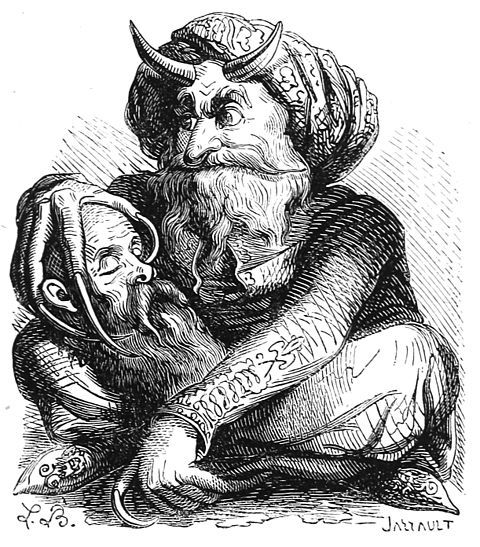
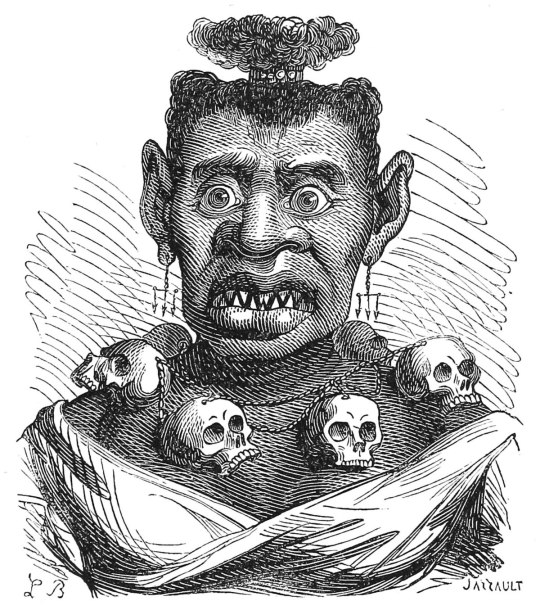
At the very least, they seem to be extremely bastardised and monstrously grotesque misrepresentations of these deities. See these more historically accurate depictions below for comparison:
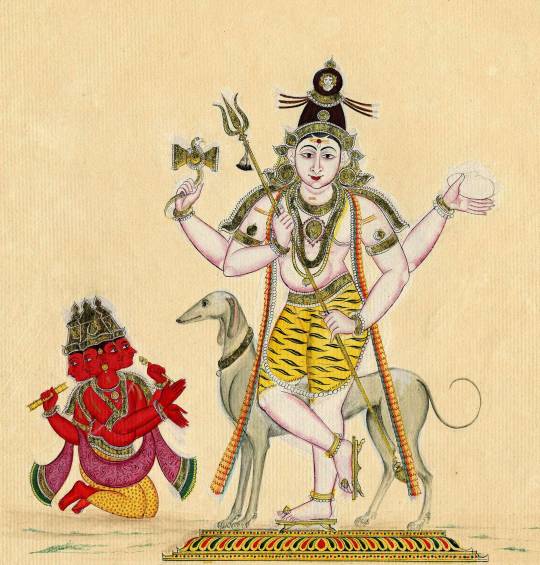
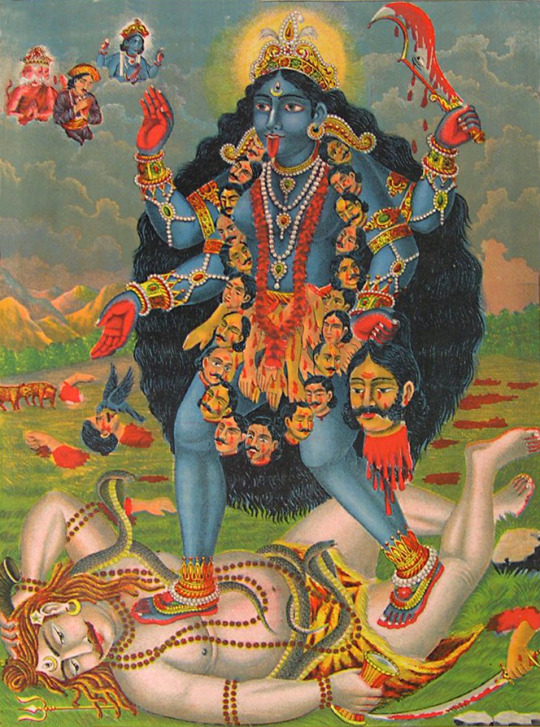
De Plancy also included entries on deities and entities such as Abraxas, Adrammelech, Alastor, Astarte, Chemosh (Chamos), Dagon, Dumuzid (Tammuz), Flaga, Guayota, Hadad (Rimmon), Milcom, Moloch, Nergal, Nibhaz (Nybbas), Nisroch, Pan, Peckols (Picollus), Pluton, Proserpina, Pucks, Rubezahl (Ribesal), Succoth-benoth, Torngarsuk, and many others that were criminally misrepresented and twisted into something they weren't.
It likely only reinforced the idea of deities such as Moloch, Chemosh, Dagan, Adrammelech, and Abraxas being considered Christianised "demons" rather than simply just deities pertaining to other religions and belief systems. Even mere underworld deities tasked with watching over the dead in the afterlife (e.g. Peckols, Pluton, Proserpina, Nergal, Dumuzid) were tainted with the stereotypical Christian idea of Hell; Fire, brimstone, pain, torment, and suffering for all of eternity.
And while some forgotten gods of dying religions might take a liking to being embraced as daemons or daemonic deities worthy of veneration in the context of Daemonolatry (as long as it's done in a respectful manner of course), these deities have still been obscenely misrepresented through the distorted perception of De Plancy's problematic views on other religions.
And that leads us into his similarly skewed views on the Daemonic Divine themselves, which isn't any better...
•──────⋆༺🕸༻⋆──────•
◦──⋆ II ⋆──◦
~ The Monstrous Misrepresentation Of Spirits ~
So not only was De Plancy a racist religiophobe (which was already rather obvious lol), but he was also quite uneducated on daemons as a whole; That is my personal opinion as both a Daemonolatrist and a Daemonologist. Having converted to Catholicism, this likely made his perception and interpretation of daemons extremely biased, because it's quite commonplace for Christianity to depict daemons in a grossly negative light.
They're basically viewed and treated like they're evil incarnate and are frequently scapegoated for most of the world's problems by religious extremists, even in the modern day. As someone who has a lot of love and respect for the Daemonic Divine, these ideas criminally misrepresent the daemons I know and love; And that goes for how they're portrayed in the Dictionnaire Infernal as well.
On top of De Plancy having a warped perception of daemons, he also seemed to have limited knowledge of the Daemonic Divine beyond their grimoire appearances; He didn't seem to have much of a UPG on them (other than the fact that he believed they were literal fallen angels who disobeyed god and were cast out of Heaven as a result), which is probably because he was biased, and didn't care to see daemons in a different perception beyond the Christian interpretation of them being the "villains".
From the thorough research I've done, it seems much more likely that daemons originate from deities pertaining to pantheons of other religions and belief systems, rather than being literal fallen angels. But that's for a whole other post in and of itself.
Aside from deities such as Baal and Astarte already being bastardised into the daemons Bael and Astaroth, as well as being depicted as such in the Dictionnaire Infernal, De Plancy himself also misinterpreted and misrepresented several deities and spirits of other folkloric backgrounds. This is very evident in his "hellish hierarchy" of spirits he considers demons included within his book. He also assigns absurdly inaccurate roles to them too. Here are just a few examples:
Kobal - This is likely a demonisation of both the Kobold sprites of Germanic mythology and the Kobaloi sprites of Greek mythology. Kobolds were commonly considered household spirits who stirred up mischief around the home. In some accounts, they were also known to do chores at night that humans neglected to finish during the day. Kobaloi were said to be impudent and mischievous spirits that were fond of tricking and frightening mortals. They were companions of Dionysus and also had the ability to shape-shift. De Plancy represented these sprites as a singular demon and assigned him with directing theatres and being somewhat of a "stage manager" in Hell.
Nybbas - This is a demonisation of a supposed deity of the Avim called Nibhaz, worshipped during the reigning of Shalmaneser I, mentioned in 2 Kings 17:31 of the Bible. Nibhaz is a rather obscure Mesopotamian deity mentioned in the Bible who was either 1) A deity whose history and mythos has been lost to time, or 2) A deity that likely never even existed in the first place. Thus, there's barely any information on Nibhaz, other than the fact that they apparently appeared in the form of a dog. De Plancy portrayed this deity as a demon under the name of Nybbas, who was in charge of managing the visions and dreams of mortals. He was said to be treated with little respect, and was regarded a "buffoon" and "charlatan".
Nergal - Here's another Mesopotamian deity that was mentioned in 2 Kings 17:31 and later demonised by De Plancy, though, Nergal seems to have a much more pronounced mythos. Nergal was a chthonic god associated with plagues, war, pestilence, death, and devastation. However, he was also said to be a benefactor to mortals; Hearing their prayers, reviving the dead, and protecting agriculture and flocks. He was equated with Irra, a god of war and scorched earth. This is probably why Nergal was later regarded as a "destroying flame" and described as "scorching". De Plancy assigned him with the role of being chief of Hell's "secret police". He is also listed as the first spy under Beelzebub's command who, in turn, is under the surveillance of "the great vigilante" Lucifer. I have absolutely no idea why Hell would even need secret police or where he even got that idea in the first place, but go figure lol. That's De Plancy for ya.
Proserpina - As far as I know, I don't think Proserpina was actually demonised prior to her appearance in the Dictionnaire Infernal. It seems that her entry within the book is the first time she was ever demonised. Proserpina is a Roman goddess (Greek equivalent: Persephone) of fertility, nature, agriculture, vegetative growth, the underworld, and the season of Spring. She is best-known for the myth of her abduction to the Underworld by the chthonic god Hades (Roman equivalent: Pluto). De Plancy includes her in his "hellish hierarchy" where he regards her as an archdiablesse (French for "archdemoness" or "arch-she-devil") and princess of evil spirits. In her grimoire entry within the Dictionnaire Infernal, she is described as being queen of the infernal empire and is associated with serpents and snakes.
Hutgin - This is another case of De Plancy demonising sprites and faeries. Hutgin is likely a demonisation of Hodekin, a kobold or sprite of Germanic folklore. Hodekin was said to be a helpful sprite and somewhat of a familiar spirit who lived with the Bishop Of Hildesheim. Hodekin was said to mainly be a nocturnal spirit and only active at night. He could see into the future and could warn one of problems to come. One of the myths surrounding Hodekin is that he was tasked with watching over the bishop's wife to make sure she remained faithful while he was away. Whenever she tried to cheat on the bishop, Hodekin would step in and assume frightening shapes, scaring the paramours away before the wife could be unfaithful. De Plancy assigns Hutgin with the role of being Hell's ambassador to the country of Turkey (for whatever reason lmao).
I don't really know how De Plancy came to such conclusions regarding daemons, deities, and other spirits; But clearly, a lot of these depictions are not very historically accurate lol. And that leads us into the next section of this post, where the depictions of the Daemonic Divine in particular weren't exactly without error in comparison to their other grimoire appearances.
•──────⋆༺🕸༻⋆──────•
◦──⋆ III ⋆──◦
~ The Inaccurate Depictions Of Daemons ~
A lot of people in occult spaces are likely familiar with Le Breton's illustrations within the Dictionnaire Infernal. However, what a lot of people don't know is that the illustrations and grimoire entries aren't very historically accurate depictions of the Daemonic Divine; That is, when you compare them to the daemons' original grimoire appearances in books such as the Livre Des Esperitz, Fasciculus Rerum Geomanticarum, Liber Officiorum Spirituum, and the Pseudomonarchia Daemonum. From the disparaging illustrated depictions to the bastardised lore, the Daemonic Divine aren't exactly documented so accurately within the Dictionnaire Infernal. Let's delve into some examples:
- - - - - - - - - -


Pruflas (also called Bufas, Suffales, Bulfas, Pruslas, and Busas) is a daemon that appears in the Livre Des Esperitz, Liber Officiorum Spirituum, Pseudomonarchia Daemonum, and the Dictionnaire Infernal.
In the Dictionnaire Infernal, Pruflas is depicted as a man with the head of an owl. But for some reason, his illustration depicts Purson rather than Pruflas (Purson is described as a lion-headed man riding a bear, also being associated with trumpets). Perhaps this was either some sort of error, or De Plancy and/or Le Breton considered Pruflas and Purson to be the same daemon, even though this is not stated anywhere in the Dictionnaire Infernal.
In the Livre Des Esperitz, Pruflas's appearance is not described. In the Liber Officiorum Spirituum, he is said to appear as a spark of fire. In the Pseudomonarchia Daemonum, he is said to appear with the body of a fiery flame and the head of a nighthawk or nightjar (described as "nycticoraci" in the original Latin version).
The term "nycticoraci" or "nycticorax" is translated to "night raven" in English. This term likely originates from Leviticus 11:16 of the Bible, which regards the "night raven" as any bird of ill omen. The specific birds regarded as night ravens mentioned in Leviticus 11 are; Eagles, vultures, black vultures, red kites, black kites, ravens, horned owls, screech owls, gulls, hawks, little owls, cormorants, great owls, white owls, desert owls, ospreys, storks, herons, hoopoes, and bats (even though bats aren't birds lol).
Later, the term "nycticorax" was used to name a specific genus of night herons. It was specifically also used to refer to the best known species, the black-crowned night heron. Given that the term "night raven" can refer to any bird of ill omen in Christianity, this may explain why daemons such as Stolas, Andras, and Aamon are depicted as either being owl-headed or taking on the appearance of an owl.
- - - - - - - - - -

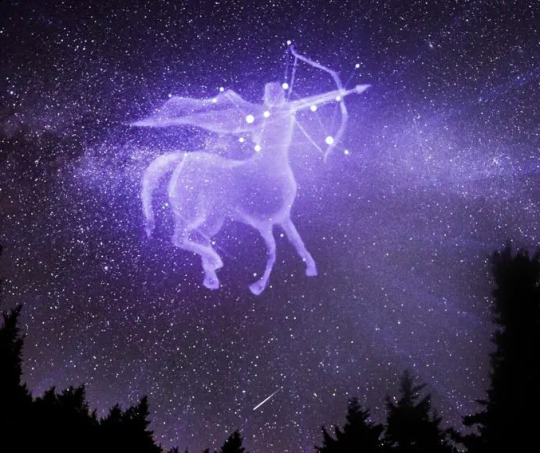
Buer (also called Gemer) is a daemon that appears in the Livre Des Esperitz, Pseudomonarchia Daemonum, Ars Goetia, and the Dictionnaire Infernal.
In the Dictionnaire Infernal, Buer is depicted as appearing in the form of a star or five-pointed wheel. Le Breton's illustration depicts him as a disembodied lion's head with five goat legs, giving him the ability to "walk" or roll in all directions. This is a historically inaccurate depiction of how Buer appears, because he isn't depicted as a quintuple-goat-legged lion head in any of his grimoire appearances whatsoever.
In the Livre Des Esperitz, Buer's appearance is not described. In the Pseudomonarchia Daemonum, he is said to appear in the form of a star. In the Ars Goetia, he is said to appear in the form of a "sagittary" or centaur, specifically when the Sun is in Sagittarius.
Buer is likely a demonisation of Chiron, a superlative centaur from Greek mythology who specialised in healing, medicine, and astrology; Which explains Buer's similar functions and the account of him appearing in the form of a "sagittary" in the Ars Goetia.
- - - - - - - - - -

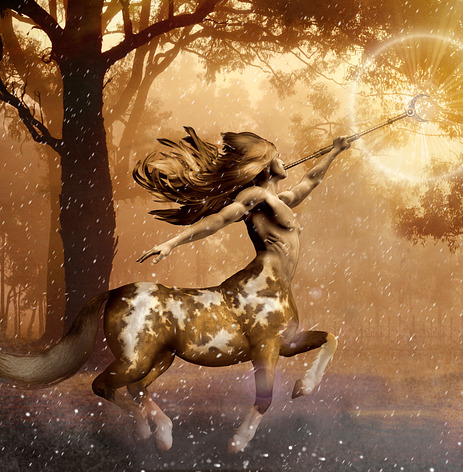
Barbatos (also called Barbates, Barbares, Barbais, Barbas, and Barbarus) is a daemon that appears in the Livre Des Esperitz, Munich Manual Of Demonic Magic, Liber Officiorum Spirituum, Pseudomonarchia Daemonum, Ars Goetia, and the Dictionnaire Infernal.
In his Dictionnaire Infernal illustration, Barbatos is depicted as a bearded hunter wielding a hunting rifle, and he is said to inhabit the forests. In his grimoire entry, he is alternatively said to appear as an archer. He is also compared to Robin Of The Woods (a.k.a. Robin Hood) and Jack In The Green.
In the Livre Des Esperitz, Barbatos's appearance is not described. In the Munich Manual Of Demonic Magic, he is said to appear as a forest archer who is accompanied by four kings carrying trumpets. In the Liber Officiorum Spirituum, he is said to appear in the form of a shouter, forest man, or wild archer. Alternatively, he is also said to appear as a centaur or "sagittary" that is described as being "half-man and half-beast". In the Pseudomonarchia Daemonum, he is said to appear in the form of a woodland archer. In the Ars Goetia, he is said to appear in the form of a "sagittary" or centaur, specifically when the Sun is in Sagittarius; Similarly to Buer.
While his form described in the Ars Goetia is said to be a mistranslation, it's not technically an inaccurate depiction. He appears as a centaur in the Liber Officiorum Spirituum, after all. His depiction as a forest man isn't too inaccurate either, given that Barbatos is possibly tied to the mythical figure Woodwose originating in medieval Europe, and functions similarly.
- - - - - - - - - -
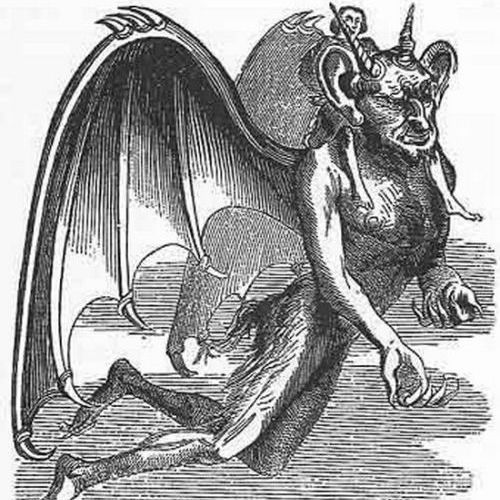

Gaap (also called Tap, Goap, Coap, Taob, Ducay, and Balath) is a daemon that appears in the Livre Des Esperitz, Munich Manual Of Demonic Magic, Liber Officiorum Spirituum, Pseudomonarchia Daemonum, Ars Goetia, and the Dictionnaire Infernal.
In the Dictionnaire Infernal, Gaap is said to appear at noon in human form. But in his illustration, he is depicted as a devil-like figure, or more plausibly, as a man riding upon the shoulders of a devil-like figure. Many people have interpreted this illustration as the demon figure being Gaap himself. But given his Dictionnaire Infernal entry, it's probably more likely that Gaap is the human mounted on the shoulders of the demon-like figure.
In the Livre Des Esperitz, Gaap's appearance is said to appear "very benignly". In the Munich Manual Of Demonic Magic, he is said to appear as a healer that assumes human form, and is also regarded as a doctor. In the Liber Officiorum Spirituum, he is said to appear as a misshapen image. In the Pseudomonarchia Daemonum, he is said to appear in a "meridional sign". In the Ars Goetia, he is said to appear in human form when the Sun is in the Southern signs.
As previously stated, it's likely that many people have interpreted Gaap's illustration as him being depicted as the devil-like figure, instead of the man that is mounted on him. Looking at his other grimoire appearances, it's likely that the illustration was meant to depict Gaap as taking the form of a human mounted on the shoulders of a devil-like being.
- - - - - - - - - -
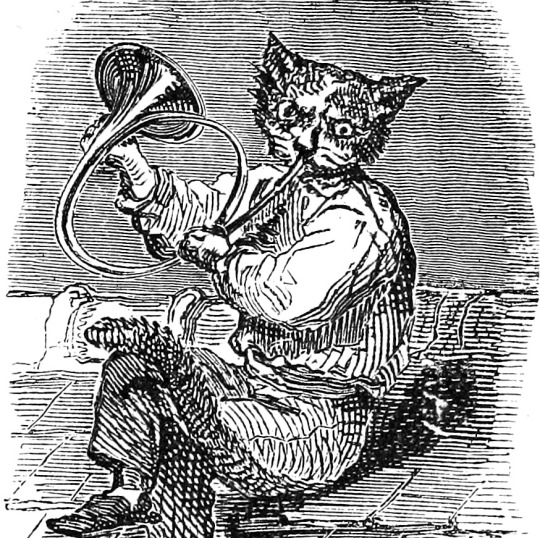

Beleth (also called Bileth, Bilet, and Byleth) is a daemon that appears in the Liber Officiorum Spirituum, Pseudomonarchia Daemonum, Ars Goetia, and the Dictionnaire Infernal.
In the Dictionnaire Infernal, she is said to appear as a "terrible" king riding a white horse, preceded by cats blowing horns and trumpets. However, her illustration seems to depict her as cat-headed person playing a horn, surrounded by dancing mice. Perhaps this illustration was meant to depict one of the horn-blowing cats that precede Beleth? I'm not sure.
In the Liber Officiorum Spirituum, Beleth's appearance is not described. In the Pseudomonarchia Daemonum, she is said to appear furiously, riding upon a pale horse; The sounding of trumpets and the playing of all sorts of other musical instruments are heard before her. In the Ars Goetia, she appears pretty much in the same way as described within the Pseudomonarchia Daemonum.
It's also just my personal UPG that Beleth is a girl lol, as I believe she likely originated from the Mesopotamian goddess Belet-ili. As far as I know, I don't think Beleth is depicted as a woman in any of her grimoire appearances. Her Dictionnaire Infernal entry and illustration don't seem to align either, so it's likely that the trumpet-blowing cat drawing was meant to depict the cats that precede Beleth, rather than Beleth herself.
- - - - - - - - - -
These are just a handful of the inaccurate depictions of the Daemonic Divine and other spirits within the Dictionnaire Infernal. If I were to delve into all of them in great detail, this post would be far too long... So I'm gonna end it there lol.
•──────⋆༺🕸༻⋆──────•
In conclusion, I personally don't advise going to the Dictionnaire Infernal as your sole source of research on daemons; Especially if you're a daemonolatrist. I'd instead recommend looking at their other grimoire appearances, especially the earlier ones. The grimoires I recommend looking into are:
Livre Des Esperitz
Fasciculus Rerum Geomanticarum
Liber Officiorum Spirituum
Pseudomonarchia Daemonum
Ars Goetia
I hope you find this post helpful! And as always, I wish you well on your spiritual path. Also, a big thanks to my friend @sortiarus-de--naturas--daemonum for helping me out with this post! I could not have written this without her. 💜
•──────⋆༺🕸༻⋆──────•
❀༻ Ave Satanas ༺❀

+. Image Sources .+ ... Nightjar Photo ... Centaur Image V1 ... Centaur Image V2 ... Flower Petals Image ... Horse Rider Image ...
#daemonolatry info posts#demonolatry#demonology#demons#dictionnaire infernal#daemonic divine#paganism#daemonolatry#daemonology#pagan#daemons#witchblr#paganblr#daemonblr#infernal dictionary#demonolatry resources
39 notes
·
View notes
Text
Make your brand stand out among the rest with The Hindu classified ads!

#hindu classified advertisement#the hindu ad booking#book ad in the hindu#the hindu advertisement#the hindu advertising#the hindu classified advertisement#the hindu ad rates#the hindu classified ad rates
0 notes
Text
Arranged in Print: The Power of Hindu Newspaper Matrimonial Ads

#the hindu matrimonial ads#the hindu matrimonial ad booking#book matrimonial ad in the hindu#hindu matrimonial ad#book the hindu matrimonial ad online#online hindu matrimonial ad booking#hindu matrimonial advertising cost
0 notes
Text
Navigate the World of Possibilities with The Hindu Classifieds!

#the hindu classified advertisement#the hindu classifieds#the hindu classified ads#the hindu ad booking#book classified ad in hindu#classified ads in hindu newspaper#hindu classified#hindu classified ads#hindu classified advertisement#hindu classified advertisement booking#hindu classified booking
0 notes
Text
So cool! Excerpts:
Founded in 427 CE, Nalanda is considered the world's first residential university, a sort of medieval Ivy League institution home to nine million books that attracted 10,000 students from across Eastern and Central Asia. They gathered here to learn medicine, logic, mathematics and – above all – Buddhist principles from some of the era's most revered scholars.
Monarchs of the Gupta Empire that founded the Buddhist monastic university were devout Hindus, but sympathetic and accepting towards Buddhism and the growing Buddhist intellectual fervour and philosophical writings of the time. The liberal cultural and religious traditions that evolved under their reign would form the core of Nalanda's multidisciplinary academic curriculum, which blended intellectual Buddhism with a higher knowledge in different fields.
Aryabhata, considered the father of Indian mathematics, is speculated to have headed the university in the 6th Century CE. "We believe that Aryabhata was the first to assign zero as a digit, a revolutionary concept, which simplified mathematical computations and helped evolve more complex avenues such as algebra and calculus," said Anuradha Mitra, a Kolkata-based professor of mathematics. "Without zero, we wouldn't have computers," she added. "He also did pioneering works in extracting square and cubic roots, and applications of trigonometrical functions to spherical geometry. He was also the first to attribute radiance of the moon to reflected sunlight."
The library's nine million handwritten, palm-leaf manuscripts was the richest repository of Buddhist wisdom in the world, and one of its three library buildings was described by Tibetan Buddhist scholar Taranatha as a nine-storey building "soaring into the clouds".
History is so fucking cool. I love stumbling across articles that teach me incredible details about things I only knew about in a very general sense (there were important centers of learning in India!). Learning mundane things like "universities have always had students sharing rooms" is just fascinating to me.
One of the small rooms that lined the courtyard where students from as far away as Afghanistan lived. Two alcoves facing each other were meant to hold oil lamps and personal belongings, and Singh explained that the small, square-shaped hollow near the entrance of the cell served as each student's personal letterbox.
How cool is that!!!
7 notes
·
View notes
Text
The war would be over by Christmas. That was what everyone said, when Britain, France, and Germany went to war in August 1914. Maybe that’s why, by the start of December, with no victory in sight, there was a pause in the fighting along parts of the Western Front stretching from Belgium through France. And maybe that’s why, when singing broke out in the trenches on Christmas Eve, soldiers on both sides decided to risk a walk up into no man’s land and even, in one recorded case, a soccer kickabout. Troops on both sides sang “Silent Night” as snow began to fall.
The truce was never formally declared by any power. Although Pope Benedict XV had called for a cease-fire earlier in the month, it had been rejected by all parties. France and Belgium had little appetite for a truce with an invading army. And in a war between global, multiethnic empires, there was little agreement about the timing or the meaning of a Christmas truce for soldiers who were Muslim, Sikh, Jewish, Hindu, or Shinto. Even for Eastern Orthodox troops on the Eastern Front, Christmas would be a few weeks later.
Instead, there were spontaneous truces along the front lines. While both sides engaged in singing, many Germans had reportedly decided not to take any action from Dec. 25 to 27. In France, near Laventie, German soldiers started putting up Christmas trees along their trenches on the 23rd and their officers requested a meeting with their British counterparts. In their book, Christmas Truce, Malcolm Brown and Shirley Seaton report that the German officers “proposed a private truce for Christmas Eve and Christmas Day” that the British officers accepted. Similar informal arrangements were made up and down the front lines, with different results in different sectors.
The informal nature of the truce meant that not everyone participated. This is partly why the truce has now attained a mythical quality—many who were on the front did not experience it and so doubted that it had taken place. Even where peace seemed to prevail, officers worried that “the truce will probably go on until someone is foolish enough to let off his rifle.”
Across the Western Front, the Christmas truces came to an end at different points. By the 27th, rain had resumed and the soldiers were once again knee-deep in mud. Along some parts of the line, fighting resumed in January. But one soldier wrote home that part of the front near Ploegsteert in Flanders didn’t really see any action from the Christmas Truce until mid-March. The Battle of Neuve Chapelle in March 1915 definitively shattered the peace. Attempts for an Easter truce in early April were largely ignored.
The Christmas Truce that took place in the first December of World War I has transcended historical curiosity to become a feature of popular memory. Pop songs, TV shows, and even ads have all made reference to the events of December 1914. Why has it adhered in this way? What has it come to symbolize, more than 100 years on?
Regular truces were a typical part of pre-modern warfare. Staged battles left time for clearing the field, burying the dead, and regrouping. Informal encounters between soldiers did not always lead to fighting, and impromptu Christmas truces occurred in the U.S. Civil War and the South African War in 1899. In a way, the Christmas Truce appeals because it seems to point to the last moment of an older form of warfare. Given the horrors of the war to come, it seems poignant in its innocence.
The popularity of the Christmas Truce of 1914—even though it was not repeated for the rest of World War I—was not just as a token of nostalgia, though. It was also responsible for creating something new: the idea that there should be a Christmas truce.
One of the enduring legacies of World War I was the shift from an approach to humanitarian principles and human rights that was “episodic, empathic, and voluntary” to, as one scholar put it, a “permanent, professionalized, and bureaucratic” responsibility of states operating in a transnational network. Alongside these developments in humanitarian organizing, truces moved out of the realm of improvised, informal agreements between soldiers. Instead, they were called for and negotiated by states and transnational peace organizations. And they did so with the Christmas Truce of 1914 as a model.
For instance, in 1965, in the midst of the escalating Vietnam War, the Viet Cong proposed a Christmas cease-fire. Meant to parallel the cease-fire that had accompanied the Vietnamese Lunar New Year celebrations earlier in the year, it was embraced back at home and internationally by the peace movement. The truce was arranged with some skepticism on the ground. Even more so given the previous year’s Christmas Eve bombing of a hotel where many U.S. officers were staying. The truce was agreed to and formally communicated to both sides.
A newspaper report from the cease-fire explicitly echoed the coverage of the 1914 truce. “It was quiet—the guns of war were stilled by a Christmas truce for the first time in almost a year,” the paper reported. “And from the top of the hill, the words of ‘silent Night’ wafted down” as the men rested their rifles on their foxholes and contemplated what the Viet Cong forces made of the song.
At the end of the 48-hour pause, both sides accused each other of violating the cease-fire. Radio Hanoi reported that “in complete disregard for their proclaimed Christmas truce, the U.S. imperialists Sunday sent many flights of aircraft.” The U.S. argued that these were reconnaissance flights, rather than bombing raids, and that the “Communists had launched at lease 60 small attacks.”
What the soldiers of World War I accidentally stumbled on was a new form of propaganda. Christmas cease-fires build morale among the troops, but also more widely. A key feature in the rhetoric of war is convincing your side that the opposing side is not just wrong, but bad. Truces and cease-fires play into this: The side proposing the cease-fire paints itself as humane. Violations of the cease-fire are fodder for arguments that the violators are inhumane.
In foreign policy, the Christmas Truce endured because it turned out to be good for both international and domestic public relations. But as a result of this realization, Christmas cease-fires also became more top-down. While the soldiers were responsible for organizing spontaneous truces along the front lines in 1914, the Christmas truces of the Vietnam War and other more recent conflicts have been ordered by leaders, often in response to international pressure. In Vietnam, despite suspicion among U.S. troops that the Viet Cong “took advantage of the truce” to rearm and resupply its forces in the south, the Christmas truce was often implemented. While this provided respite and a chance for point-scoring in the media, some U.S. soldiers were left asking, “What good would it do?”
And they asked that with good reason. Christmas—and other religious holidays—have been just as likely to mark the beginning of a campaign, taking advantage of the enemy’s hope for some respite. George Washington crossed the Delaware River on Christmas 1776, surprising the British-allied Hessian troops in Trenton. During the Tet Offensive in the Vietnam War, the Viet Cong took advantage of the Lunar New Year in 1968 to attack while many of South Vietnam’s soldiers were on holiday leave. And then-U.S. President Richard Nixon broke the expected Christmas Truce tradition in 1972 when the U.S. launched its largest B-52 raid on North Vietnam in the course of the war. The Yom Kippur War in Israel began on the Jewish holiday in 1973. Operation Ramadan in the Iran-Iraq War launched to coincide with the holy month in 1982.
This explains the unease of the leadership in December 1914. In Laventie, one group of British soldiers was about to withdraw from the trenches on the 26th when a German deserter, taking advantage of the truce, crossed to warn them that an attack was imminent. The British soldiers fired artillery at the German trenches and then lay in wait for the attack. But it never came. And the Germans, put on alert by the artillery fire, similarly had spent the night in anticipation of a British attack.
In fact, while the 1914 Christmas Truce saw soldiers sharing tobacco and wine, Christmas puddings and songs at scattered locations along the trenches in Belgium and France, the Germans dropped their first aerial bomb on Britain, at Dover on Christmas Eve. On Christmas Day, the British used seaplanes to attack the Imperial German Navy, stationed in the harbor of Cuxhaven.
The 1914 Christmas Truce in particular has been read in popular culture as a moment when soldiers rejected their officers’ orders and rejected the nationalist propaganda that they had been exposed to, which demonized their opponents. The Christmas Truce appeals to the idea that ordinary people would get along if only they weren’t ordered to fight each other by their governments. In 1914, soldiers ignored officers and took risks to make human connections with people they were supposed to hate.
Christmas truces have subsequently become a regular prop in international diplomacy. In conflicts ranging from the Philippines to Colombia, Sudan to Ukraine, it’s hard not to see the Christmas Truce as having retained its mythical status precisely because of its usefulness as propaganda. Perhaps it would be better to remember the Christmas Truce as one poem concluded in January 1915: “God speed the time when every day/Shall be as Christmas Day!”
42 notes
·
View notes
Note
i’ve like, watched bits and pieces of mahabharata adaptations, heard a gazillion people talk about what happens in it, and also one random netflix show where they’re judging the characters in heaven?? anyway. my thing was that i’ve never consistently watched/read it, and since it’s such a big corpus of work…. is there like a summary? a list of events? like a wiki?? it’d help a lot
I'm always hesitant to give out singular recommendations for anything, honestly, because I feel like no singular piece of work could ever properly capture every nuance and discourse. A lot of said pieces of work also have stuff that I find objectionable so I cannot endorse them without adding essays worth of caveats.
I wish I had a personalised summary for you that I could tell you to read/watch/listen to for a start. (maybe I should make one? No. That'd be insane of me. That'll take YEARS. It'd be a Project. I couldn't do that. Could I?)
If you're just starting out, maybe some of the compiled and heavily summarised versions would help. Children's book versions of the epic can be helpful to start with, they sanitise and flatten things but as a summary, they work. If you're grown up, it might feel a little odd to be reading children's books but I think they serve their purpose of being little cliffnotes version of events. Baby me had this book called Puffin's The Mahabharata by Namita Gokhale that I liked. I haven't read that book in years so I cannot give you an updated opinion on it.
Jaya by Devdutt Pattanaik also has quick summaries of events, often in bullet point formats which one could find helpful. However, Devdutt Pattanaik has a Thing™ where he's the gateway drug to Hindu supremacist nonsense so you have to watch out for that. Be So Careful, my dude. (My issue of being unable to recommend something without caveats and warnings in action, ladies, gentlemen and theyloveds.)
There's also stuff like Wikipedia, various websites with summaries etc. I would recommend checking citations on those as much as possible. You can peruse through those too.
Once you get a basic level of familiarity, you'll soon realise that everybody disagrees with everybody on events and characterization and there's millions of different versions and there's no "canon". It's chaos out here and that's the beauty of it all. Happy reading!
-Mod S
13 notes
·
View notes